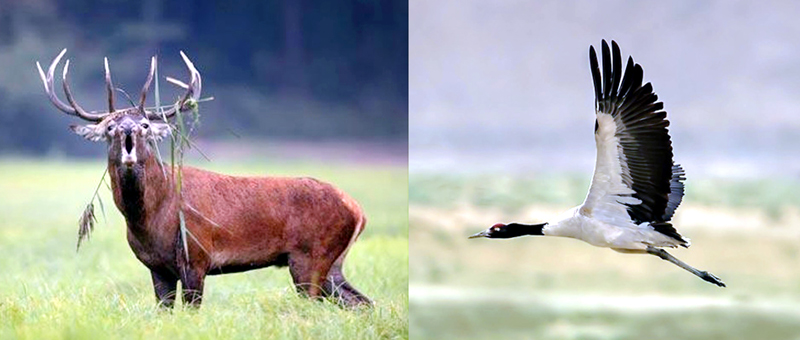*Slackness delaying completion of distinctive task
Mohinder Verma
JAMMU, May 1: Even one and half year after their creation, the Union Territory of Jammu and Kashmir and Union Territory of Ladakh have failed to identify new State Bird and Animal, the task which was created by the Reorganization Act, 2019.
Due to this, these are the only two Union Territories in the entire country which don’t have such important symbols and dilly-dallying approach on the part of the concerned authorities is responsible for the same.
The erstwhile State of Jammu and Kashmir had Black-necked Crane as State Bird and Kashmir Stag (Hangul) as State Animal. Both these species are rarest of the rare as such were declared as official symbols long time back.
The bifurcation of the State, as per the provisions of Jammu and Kashmir State Reorganization Act, 2019, created a task of its own kind for the administration-identification and declaration of new State Bird and Animal of Union Territory of Jammu and Kashmir and Union Territory of Ladakh.
Black-necked Crane, which is found only in Eastern Ladakh, is no longer the State Bird of Union Territory of Jammu and Kashmir while as Kashmir Stag (Hangul), which is found only in Valley, cannot be State Animal of Union Territory of Ladakh.
“The issue of identification of new State Bird for Union Territory of Jammu and Kashmir and new State Animal for the Union Territory of Ladakh was discussed in certain official meetings held in the respective UTs but final decision has yet not been taken”, official sources told EXCELSIOR.
“In these meetings some officers even made mention of certain birds and animals which are exclusively found in these two Union Territories but still no headway has been made mainly because of slackness on the part of the concerned authorities”, they further said, adding “in the year 2019 it was announced by the Government of J&K UT that task of identification of new State Bird would be assigned to a committee of officers but thereafter no seriousness was shown”.
“Had the task created by the J&K Reorganization Act been taken seriously by both the UTs more than one and half year was sufficient period to identify new State Bird and Animal”, sources said, adding “due to this J&K and Ladakh are the only two UTs in the entire country which don’t have such important symbols”.
It is pertinent to mention here that every State and Union Territory of India has a unique group of symbols like State Animal and Bird. These symbols have been chosen from unique flora and fauna and they depict a certain virtue that is distinctive characteristic of the State or Union Territory.
These symbols are often adopted after concerted efforts by the Governments to have a significant item recognized for its importance to the State or Union Territory. Moreover, these symbols represent the culture and the natural wonders unique to the particular State.
The Black-necked Crane, the State Bird of Ladakh, is the last of the world’s cranes to be discovered by the scientific community. In Ladakh, the Black-Necked Crane was first reported in 1919 by a naturalist at Tsokar during a bird collection trip. Now, highly vulnerable specie the Black-necked Crane inhabits a region that is geographically inaccessible for much of the year.
In India, Eastern Ladakh is the only known breeding ground of the Black-necked Crane outside of China. WWF-India in collaboration with the Department of Wildlife Protection has been working actively for the conservation of Black-necked Crane at various wetlands in Ladakh.
Kashmir Stag, popularly known as Hangul, is the only surviving sub-species of the Red Deer family. Once found in high altitude regions of Northern India and Pakistan, the Kashmir Stag is now confined to only Dachigam National Park in Kashmir. It has been considered as one of the rarest mammal in the subcontinent since 1950s.
The population of Hangul has decreased so low over a period of time that it has been classified as critically endangered by the International Union for Conservation of Nature’s Red Data Book.


